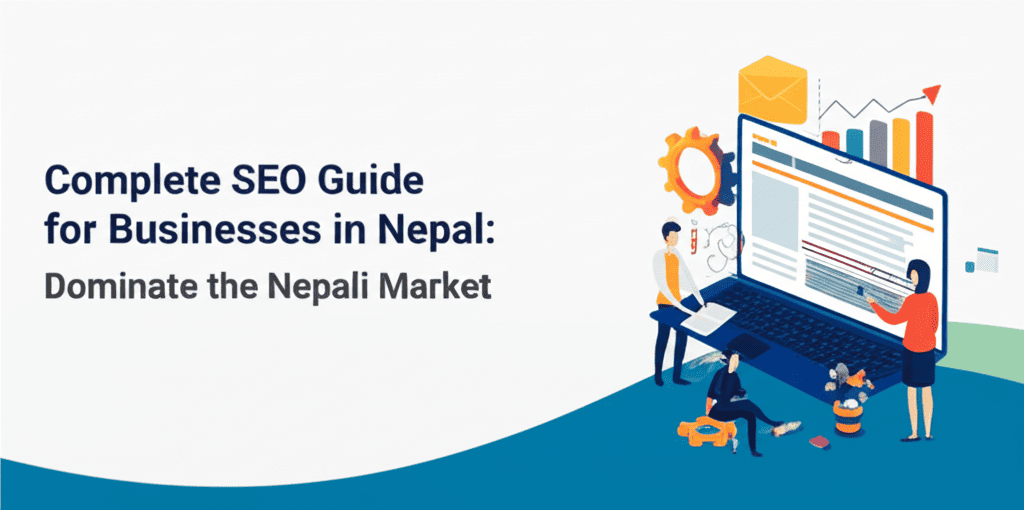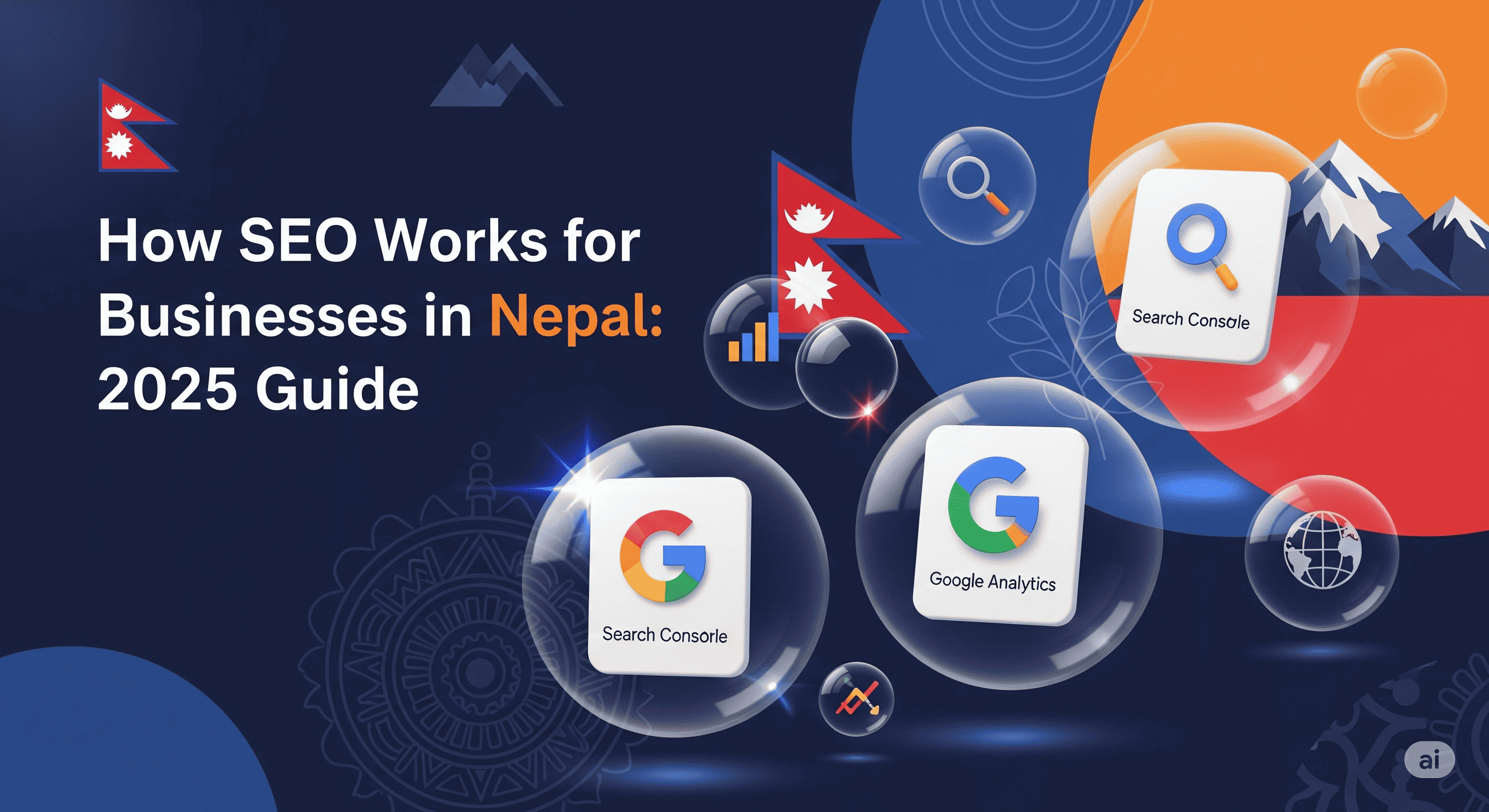In the dynamic landscape of the Nepali market, Search Engine Optimization (SEO) is no longer optional; it's essential. This comprehensive guide is designed to equip Nepali businesses with the knowledge and strategies needed to conquer search engine rankings, attract targeted traffic, and achieve sustainable online growth. From foundational principles to advanced techniques, we'll explore every facet of SEO, tailored specifically for the unique challenges and opportunities within Nepal. Get ready to transform your online presence and unlock your business's full potential.
Understanding SEO Fundamentals: How Does SEO Work for Nepali Businesses?
What is SEO and Why Is It Crucial for Businesses in Nepal?
Search Engine Optimization (SEO) is the practice of optimizing your website to rank higher in search engine results pages (SERPs) like Google, Bing, and Yahoo. For Nepali businesses, SEO is crucial because it increases visibility to potential customers actively searching for products or services online. With a growing number of Nepali consumers using the internet, particularly on mobile devices, SEO allows you to reach a wider audience and compete effectively in the digital marketplace. Think of it as your storefront in the digital world; SEO ensures that your store is visible and attractive to potential customers.
How Do Search Engines Work: Crawling, Indexing, and Ranking Explained?
Search engines like Google use a process called crawling, indexing, and ranking to deliver relevant search results. Crawling involves search engine bots (also known as spiders) exploring the internet, following links from one page to another to discover new content. Indexing is the process of analyzing and storing the information gathered during crawling in a massive database. Finally, ranking determines the order in which search results are displayed based on various factors, including relevance, authority, and user experience. Understanding this process is key to optimizing your website for better visibility in Nepal. For example, ensuring your site is easily crawlable helps Google find and index your content faster.
Key SEO Ranking Factors: A Nepali Business Perspective
Several factors influence your website's ranking in search results. From a Nepali business perspective, some of the most important include:
Keyword Relevance: Using relevant keywords that Nepali customers are searching for. Content Quality: Creating informative and engaging content that provides value to your audience.
Backlinks: Earning high-quality backlinks from reputable Nepali websites.
Mobile-Friendliness: Ensuring your website is optimized for mobile devices, given the high mobile internet usage in Nepal.
Website Speed: Improving website loading time for a better user experience.
Local SEO: Optimizing your website for local searches, such as "restaurants in Kathmandu." Addressing these factors will significantly boost your SEO performance in the Nepali market. For instance, a local restaurant could target keywords like "best momo in Kathmandu" and build citations on Nepali business directories.
Differentiating SEO from SEM: Which Is Right for Your Nepali Business?
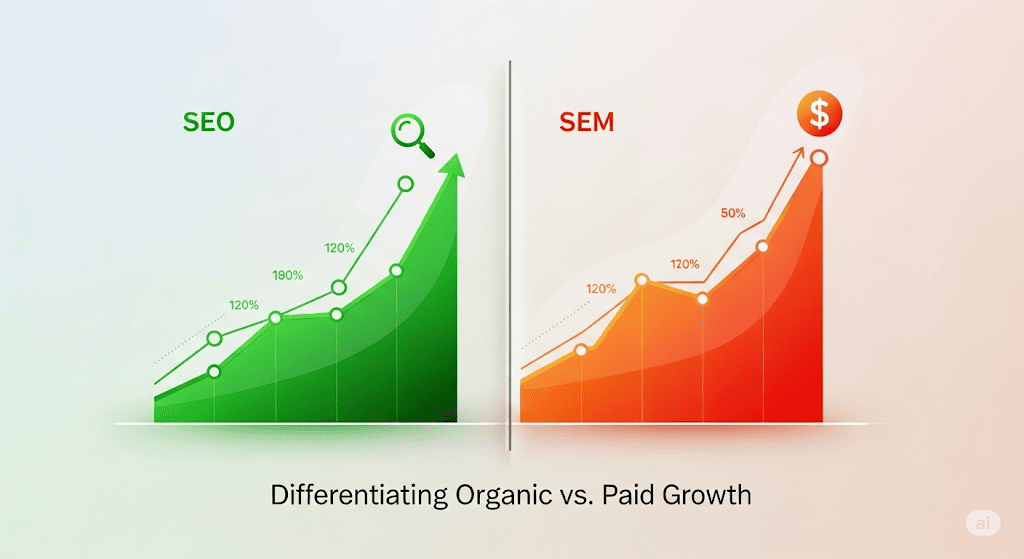
SEO (Search Engine Optimization) and SEM (Search Engine Marketing) are both strategies for improving your website's visibility in search results, but they differ in their approach. SEO is an organic approach, focusing on optimizing your website to rank higher in unpaid search results. SEM, on the other hand, involves paid advertising, such as Google Ads, to display your website at the top of search results. While SEO offers long-term benefits and sustainable growth, SEM provides immediate visibility and targeted traffic. For Nepali businesses, a combination of both SEO and SEM can be effective. Use SEO for long-term organic growth and SEM to drive immediate results and target specific keywords or demographics. For example, a new business might use Google Ads to quickly attract customers while simultaneously working on SEO to build a lasting online presence.
On-Page SEO Mastery: Optimizing Your Website for Nepali Searchers
Keyword Research for Nepal: Identifying High-Value Keywords for Your Business
Keyword research is the foundation of any successful SEO strategy. For Nepali businesses, it involves identifying the keywords that your target audience is using when searching for your products or services. Start by brainstorming relevant keywords related to your business. Use keyword research tools like Google Keyword Planner, Ahrefs, or SEMrush to discover additional keywords, analyze their search volume, and assess their competition. Consider using long-tail keywords (longer, more specific phrases) to target a niche audience and improve your chances of ranking. For example, instead of just "mobile phone," target "best smartphone under 20000 in Nepal." Understanding Nepali search behavior and incorporating relevant keywords into your website content is essential.
Optimizing Title Tags and Meta Descriptions: Attracting Clicks from Nepali Search Results
Title tags and meta descriptions are HTML elements that appear in search results and provide a brief description of your webpage. Optimizing these elements is crucial for attracting clicks from Nepali searchers. Your title tag should be concise, descriptive, and include your target keyword. Keep it under 60 characters to ensure it's fully visible in search results. Your meta description should provide a compelling summary of your webpage's content and encourage users to click. Keep it under 160 characters. Use persuasive language and include a call to action. For example, a title tag for a Nepali trekking company could be "Everest Base Camp Trek | Best Trekking Company Nepal" and the meta description could be "Experience the adventure of a lifetime with our guided Everest Base Camp treks. Book now!"
Crafting High-Quality Content: Creating Engaging and Informative Content for Your Nepali Audience
High-quality content is the cornerstone of any successful SEO strategy. Your content should be engaging, informative, and relevant to your Nepali audience. Focus on providing value to your readers by answering their questions, solving their problems, and offering unique insights. Create different types of content, such as blog posts, articles, videos, and infographics, to cater to different preferences. Optimize your content for readability by using clear headings, subheadings, and bullet points. Incorporate relevant keywords naturally throughout your content. Remember, content is king, and creating high-quality content will not only attract more visitors to your website but also improve your search engine rankings. For instance, a Nepali e-commerce site could create blog posts like "Top 5 Smartphones to Buy in Nepal This Year" or "How to Dress for a Nepali Wedding."
Image Optimization: Improving Website Speed and SEO with Optimized Images
Images can significantly enhance your website's visual appeal and user experience. However, large image files can slow down your website's loading time, which can negatively impact your SEO. Optimizing your images involves reducing their file size without sacrificing quality. Use image editing tools like Photoshop, GIMP, or online image compressors to optimize your images. Choose the right file format (JPEG for photographs, PNG for graphics). Add descriptive alt text to your images, which helps search engines understand what the image is about. Alt text is also important for accessibility, as it provides a description of the image for visually impaired users. For example, an image of a Pashmina shawl could have alt text like "Handwoven Pashmina Shawl from Nepal."
Internal Linking: Guiding Users and Search Engines Through Your Website
Internal linking involves linking from one page of your website to another. It helps users navigate your website more easily and helps search engines discover and index your content. When creating internal links, use relevant anchor text (the clickable text of the link) that accurately describes the destination page. Link to your most important pages to increase their visibility and authority. Avoid overusing internal links, as it can appear spammy. A well-structured internal linking strategy can improve your website's user experience, increase page views, and boost your SEO rankings. For example, a blog post about Nepali cuisine could link to other blog posts about specific Nepali dishes or restaurants.
Mobile-Friendliness: Ensuring a Seamless Experience for Nepali Mobile Users
With the increasing use of mobile devices in Nepal, ensuring your website is mobile-friendly is crucial. Mobile-friendliness means that your website is designed to be easily viewed and navigated on smartphones and tablets. Use a responsive design, which automatically adjusts your website's layout to fit different screen sizes. Optimize your website's loading speed, as mobile users are often impatient. Use large, easy-to-click buttons and links. Avoid using Flash, which is not supported by most mobile devices. Test your website on different mobile devices to ensure it provides a seamless user experience. Google also uses mobile-first indexing, meaning it primarily uses the mobile version of your website for indexing and ranking. Prioritize mobile-friendliness to attract and retain Nepali mobile users.
URL Structure: Creating SEO-Friendly URLs for Better Rankings
Your website's URL structure plays a role in SEO. Create SEO-friendly URLs that are concise, descriptive, and include your target keyword. Use hyphens to separate words in your URLs. Avoid using underscores, spaces, or special characters. Keep your URLs short and easy to remember. A well-structured URL can help search engines understand what the page is about and improve your rankings. For example, instead of a URL like "www.example.com/page123," use "www.example.com/nepali-cuisine."
Off-Page SEO Strategies: Building Authority and Trust in the Nepali Market
Link Building: Earning High-Quality Backlinks from Reputable Nepali Websites
Link building is the process of acquiring backlinks (links from other websites to your website). Backlinks are a crucial ranking factor, as they signal to search engines that your website is authoritative and trustworthy. Focus on earning high-quality backlinks from reputable Nepali websites. Avoid engaging in black-hat link building tactics, such as buying links, as they can harm your website's ranking. Some effective link building strategies include:
Guest Blogging: Writing guest posts for other Nepali websites in your industry.
Broken Link Building: Finding broken links on other websites and offering your content as a replacement.
Resource Link Building: Creating valuable resources (e.g., guides, checklists) that other websites will link to. Building strong relationships with other Nepali businesses and websites is key to successful link building.
Social Media Marketing: Leveraging Social Media to Drive Traffic and Build Brand Awareness
Social media marketing is a powerful tool for driving traffic to your website and building brand awareness in the Nepali market. Create profiles on popular social media platforms like Facebook, Instagram, Twitter, and LinkedIn. Share engaging and informative content that is relevant to your target audience. Use social media to interact with your customers, answer their questions, and address their concerns. Run social media contests and giveaways to increase engagement and build your following. Use social media advertising to reach a wider audience and target specific demographics in Nepal. Remember, social media is not just about promoting your products or services; it's about building relationships with your customers and creating a community around your brand.
Online Reputation Management: Protecting Your Brand's Reputation Online
Your online reputation is crucial for attracting and retaining customers. Monitor your online reputation by tracking mentions of your brand on social media, review websites, and other online platforms. Respond promptly and professionally to both positive and negative reviews. Address any negative feedback constructively and try to resolve any issues to the customer's satisfaction. Encourage satisfied customers to leave positive reviews. Use online reputation management tools to track your brand's sentiment and identify potential issues. Protecting your brand's reputation online is an ongoing process that requires vigilance and proactive management. For instance, if a customer leaves a negative review about slow service, publicly acknowledge the issue and outline steps taken to improve.
Digital PR: Securing Mentions and Coverage in Nepali Media Outlets
Digital PR involves securing mentions and coverage in Nepali media outlets, such as newspapers, magazines, and online publications. This can help increase your brand awareness, build your authority, and drive traffic to your website. Develop relationships with journalists and media professionals in Nepal. Send out press releases to announce new products, services, or company milestones. Offer to provide expert commentary on industry trends. Participate in relevant industry events and conferences. Digital PR can be a powerful way to reach a wider audience and establish your brand as a leader in your industry. Focus on building genuine relationships rather than simply seeking promotional opportunities.
Influencer Marketing: Partnering with Local Influencers to Reach a Wider Audience
Influencer marketing involves partnering with local influencers (individuals with a large and engaged following on social media) to promote your brand to their audience. Identify influencers in Nepal who are relevant to your industry and target audience. Reach out to them and offer them a partnership opportunity. This could involve providing them with free products or services in exchange for a review or social media post. Ensure that the influencer's values align with your brand values. Be transparent about the partnership and disclose that the content is sponsored. Influencer marketing can be a cost-effective way to reach a wider audience and build trust with potential customers. Carefully vet influencers to ensure their audience is genuine and relevant to your target market.
Technical SEO: Ensuring Your Website is Search Engine Friendly for Nepal
Website Speed Optimization: Improving Website Loading Time for a Better User Experience
Website speed is a critical ranking factor. Slow loading times can frustrate users and lead to higher bounce rates, negatively impacting your SEO. Optimize your website's loading time by:
Optimizing Images: Compressing images without sacrificing quality.
Enabling Browser Caching: Allowing browsers to store static resources.
Minifying CSS and JavaScript: Reducing the size of your code files.
Using a Content Delivery Network (CDN): Distributing your website's content across multiple servers. Test your website's speed using tools like Google PageSpeed Insights or GTmetrix. Aim for a loading time of under three seconds. Fast loading times provide a better user experience and improve your search engine rankings.
Mobile-First Indexing: Optimizing Your Website for Mobile-First Indexing
Google uses mobile-first indexing, meaning it primarily uses the mobile version of your website for indexing and ranking. Ensure your website is fully optimized for mobile devices. Use a responsive design that adapts to different screen sizes. Make sure your mobile website loads quickly. Use large, easy-to-click buttons and links. Ensure that all content and functionality available on your desktop website are also available on your mobile website. Test your website on different mobile devices to ensure it provides a seamless user experience. Failing to optimize for mobile-first indexing can significantly harm your website's rankings.
XML Sitemap: Submitting Your Sitemap to Search Engines for Easier Crawling
An XML sitemap is a file that lists all the pages on your website, helping search engines discover and crawl your content more efficiently. Create an XML sitemap using a sitemap generator tool. Submit your sitemap to Google Search Console and Bing Webmaster Tools. Update your sitemap regularly whenever you add new pages or make changes to existing pages. A well-structured sitemap helps search engines understand the structure of your website and index your content more effectively.
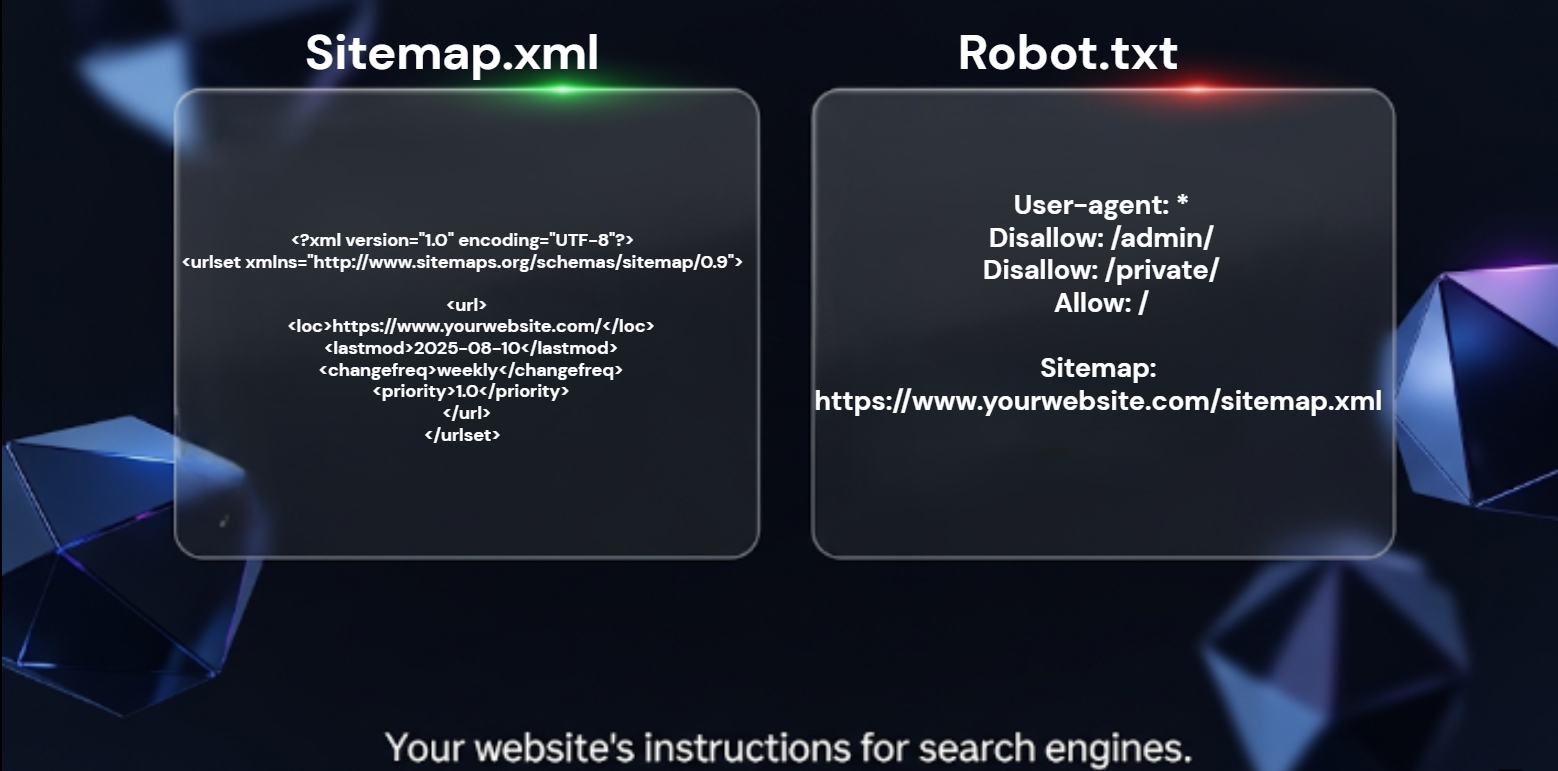
Robots.txt File: Controlling Search Engine Crawlers' Access to Your Website
The robots.txt file is a text file that tells search engine crawlers which pages on your website they are allowed to crawl and which pages they should ignore. Use the robots.txt file to prevent crawlers from accessing sensitive or duplicate content. Be careful when using the robots.txt file, as blocking crawlers from accessing important pages can harm your SEO. You can use the robots.txt tester in Google Search Console to ensure your file is configured correctly. Proper use of robots.txt ensures that search engines focus on indexing your most important content.
Structured Data Markup: Implementing Schema Markup to Enhance Search Engine Understanding
Structured data markup (also known as schema markup) is code that you add to your website to provide search engines with more information about your content. This helps search engines understand the context of your content and display it more effectively in search results. Use schema markup to identify different types of content, such as articles, products, events, and reviews. Google uses structured data to generate rich snippets, which are enhanced search results that can include additional information such as ratings, prices, and images. Implementing structured data markup can improve your website's visibility and click-through rate in search results.
HTTPS Implementation: Securing Your Website with HTTPS
HTTPS (Hypertext Transfer Protocol Secure) is a secure version of HTTP that encrypts the communication between your website and your users' browsers. Implementing HTTPS is essential for protecting your users' data and building trust. Google also uses HTTPS as a ranking factor. Obtain an SSL certificate from a trusted certificate authority. Install the SSL certificate on your web server. Configure your website to redirect all HTTP traffic to HTTPS. Update all internal links to use HTTPS. Implementing HTTPS is a crucial step in securing your website and improving your SEO.
Local SEO for Nepali Businesses: Attracting Local Customers
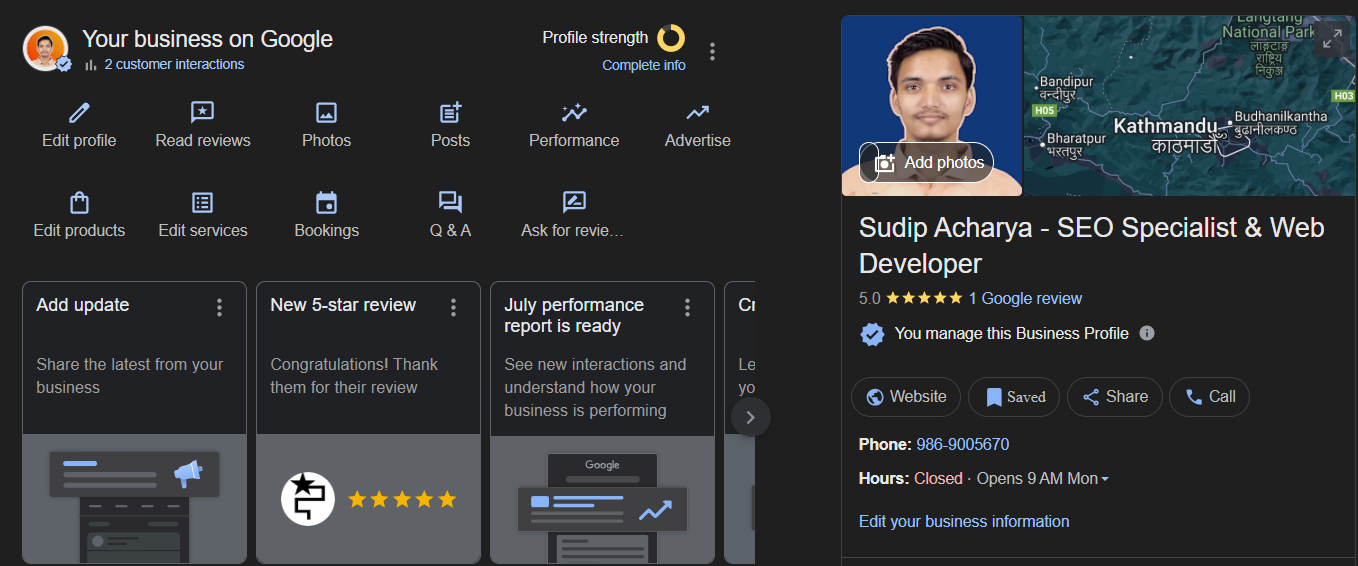
Google My Business Optimization: Claiming and Optimizing Your Google My Business Profile
Google My Business (GMB) is a free business listing on Google that allows you to manage your online presence across Google Search and Maps. Claim and verify your GMB profile. Provide accurate and up-to-date information about your business, including your name, address, phone number, website, and hours of operation. Choose relevant categories for your business. Add high-quality photos of your business, including your storefront, products, and team. Respond to customer reviews promptly and professionally. Optimizing your GMB profile is crucial for attracting local customers and improving your visibility in local search results. Make sure your business address matches the address listed on your website and other online directories.
Local Keyword Research: Targeting Local Keywords to Reach Customers in Your Area
Local keyword research involves identifying the keywords that your target audience is using when searching for local businesses in your area. Use keyword research tools to discover local keywords related to your business. Include your city and region in your keywords. For example, instead of just "restaurant," target "restaurants in Kathmandu." Use local keywords in your website content, title tags, meta descriptions, and GMB profile. Targeting local keywords can help you attract more local customers and improve your visibility in local search results.
NAP Citations: Building Consistent NAP Citations Across the Web
NAP citations are online mentions of your business's name, address, and phone number. Building consistent NAP citations across the web is crucial for local SEO. Ensure that your NAP information is accurate and consistent on your website, GMB profile, and all other online directories. Submit your business to relevant local directories, such as Yellow Pages, Yelp, and local business directories. Building consistent NAP citations helps search engines verify your business's location and improve your local search rankings. Regularly check your NAP citations for accuracy and update any outdated information.
Online Reviews: Encouraging Customers to Leave Positive Reviews
Online reviews play a significant role in local SEO. Positive reviews can attract more customers and improve your search rankings. Encourage satisfied customers to leave positive reviews on Google, Yelp, and other review websites. Make it easy for customers to leave reviews by providing them with direct links to your review profiles. Respond to all reviews, both positive and negative, promptly and professionally. Addressing negative reviews constructively can show potential customers that you care about their feedback. Positive reviews build trust and influence purchasing decisions.
Local Link Building: Earning Backlinks from Local Nepali Websites
Local link building involves earning backlinks from other local Nepali websites. This can help improve your local search rankings and attract more local customers. Some effective local link building strategies include:
Sponsoring Local Events: Sponsoring local events and getting a link from the event website.
Joining Local Business Organizations: Joining local business organizations and getting a link from their website.
Guest Blogging for Local Blogs: Writing guest posts for local blogs and websites. Building relationships with other local businesses and organizations is key to successful local link building.
Paid Advertising (PPC) as an SEO Supplement: Amplifying Your Reach in Nepal
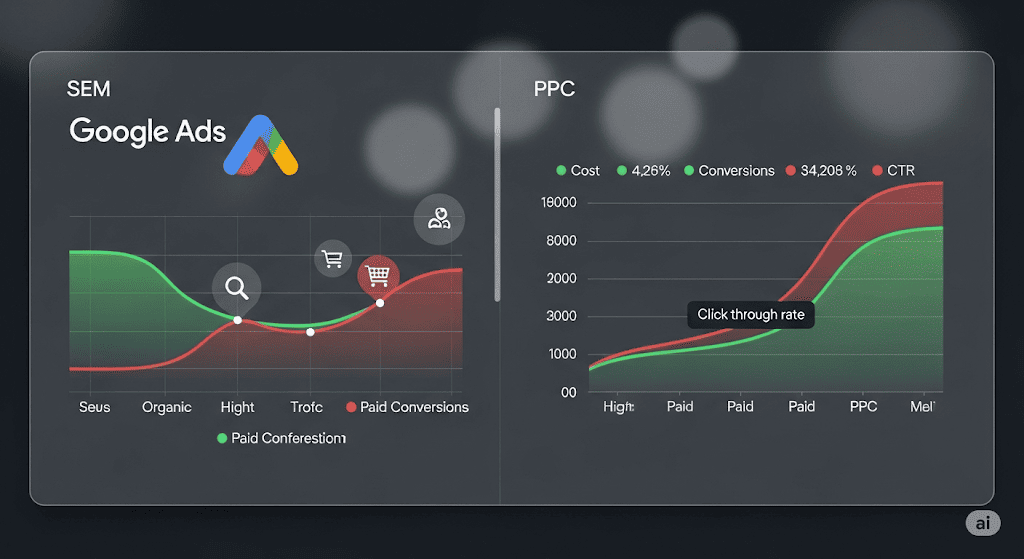
Introduction to Google Ads for Nepali Businesses
Google Ads is a paid advertising platform that allows you to display your ads in Google search results and on other websites across the Google Display Network. For Nepali businesses, Google Ads can be a powerful tool for driving targeted traffic to your website and generating leads. Google Ads offers a variety of targeting options, including keywords, demographics, and location. You only pay when someone clicks on your ad, making it a cost-effective way to reach potential customers. Google Ads can be used to supplement your SEO efforts and drive immediate results.
Keyword Research for PPC: Finding the Right Keywords for Your Ads
Keyword research is essential for creating successful Google Ads campaigns. Use keyword research tools to identify the keywords that your target audience is using when searching for your products or services. Choose keywords that are relevant to your business and have a high search volume. Use negative keywords to prevent your ads from showing for irrelevant searches. Group your keywords into tightly themed ad groups. Careful keyword research can help you target the right audience and improve the performance of your ads.
Creating Compelling Ad Copy: Attracting Clicks from Nepali Searchers
Your ad copy is the text that appears in your Google Ads. It's crucial to create compelling ad copy that attracts clicks from Nepali searchers. Your ad copy should be concise, descriptive, and include your target keyword. Highlight the benefits of your product or service. Include a call to action, such as "Buy Now," "Learn More," or "Get a Free Quote." Use A/B testing to test different versions of your ad copy and see which performs best. Compelling ad copy can improve your click-through rate (CTR) and drive more traffic to your website.
Landing Page Optimization: Converting Ad Clicks into Customers
Your landing page is the page that users are directed to when they click on your ad. It's crucial to optimize your landing page to convert ad clicks into customers. Your landing page should be relevant to your ad copy and keywords. Provide clear and concise information about your product or service. Include a strong call to action. Make it easy for users to contact you or make a purchase. Optimize your landing page for mobile devices. A well-optimized landing page can improve your conversion rate and maximize your return on investment (ROI).
Tracking and Measuring PPC Performance: Optimizing Your Campaigns for Maximum ROI
Tracking and measuring your PPC performance is essential for optimizing your campaigns and maximizing your ROI. Use Google Analytics to track website traffic, user behavior, and conversions. Use Google Ads conversion tracking to track the number of leads and sales generated by your ads. Monitor your key performance indicators (KPIs), such as click-through rate (CTR), cost per click (CPC), conversion rate, and ROI. Use this data to identify areas for improvement and optimize your campaigns. Regularly review and adjust your campaigns to ensure they are performing effectively.
Analyzing and Measuring Your SEO Efforts: Tracking Your Progress in the Nepali Market
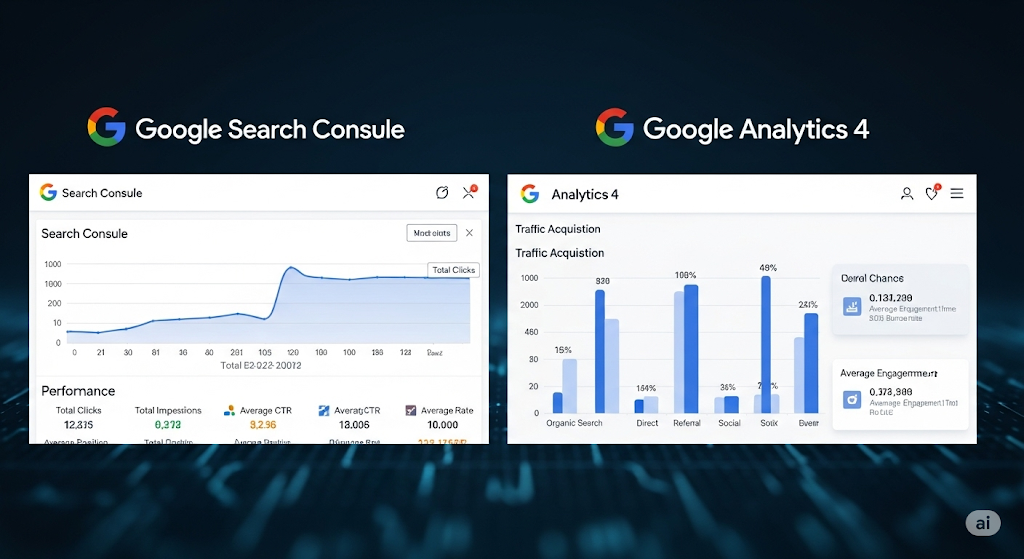
Using Google Analytics: Tracking Website Traffic, User Behavior, and Conversions
Google Analytics is a free web analytics tool that allows you to track website traffic, user behavior, and conversions. Set up Google Analytics on your website. Track key metrics such as page views, bounce rate, time on site, and conversions. Use Google Analytics to understand where your traffic is coming from, which pages are most popular, and how users are interacting with your website. This data can help you identify areas for improvement and optimize your SEO strategy. Analyze data regularly to make informed decisions.
Using Google Search Console: Monitoring Your Website's Performance in Search Results
Google Search Console is a free tool that allows you to monitor your website's performance in Google search results. Verify your website in Google Search Console. Monitor your website's search traffic, crawl errors, and security issues. Use Google Search Console to submit your sitemap and request indexing of new pages. Identify keywords that are driving traffic to your website. This data can help you identify technical issues, optimize your content, and improve your search rankings.
Keyword Ranking Tracking: Monitoring Your Keyword Rankings Over Time
Keyword ranking tracking involves monitoring your website's ranking for specific keywords over time. Use a keyword ranking tracking tool to track your keyword rankings. Monitor your rankings for your target keywords. Identify keywords that are improving in rankings and keywords that are declining. This data can help you understand the effectiveness of your SEO efforts and identify areas where you need to improve. Track rankings weekly or monthly for best insights.
Competitor Analysis: Analyzing Your Competitors' SEO Strategies
Competitor analysis involves analyzing your competitors' SEO strategies to identify their strengths and weaknesses. Identify your main competitors in the Nepali market. Analyze their website content, keyword targeting, link building strategies, and social media presence. Use competitor analysis tools to track their keyword rankings and backlinks. This data can help you identify opportunities to improve your own SEO strategy and gain a competitive advantage. Stay informed about what competitors are doing to stay ahead.
Reporting and Analysis: Creating Reports to Track Your SEO Progress
Reporting and analysis involves creating regular reports to track your SEO progress and communicate your results to stakeholders. Create reports that include key metrics such as website traffic, keyword rankings, conversions, and ROI. Use data visualization tools to present your data in a clear and concise manner. Analyze your data to identify trends and patterns. Use your reports to inform your SEO strategy and make data-driven decisions. Share reports monthly or quarterly with stakeholders.
Staying Updated with SEO Trends in Nepal: Future-Proofing Your Strategy
Following Industry News and Blogs: Staying Informed About the Latest SEO Trends
The SEO landscape is constantly evolving, so it's important to stay informed about the latest trends and best practices. Follow industry news and blogs from reputable sources. Subscribe to SEO newsletters. Attend SEO webinars and conferences. By staying informed, you can ensure that your SEO strategy is up-to-date and effective. Adapt to new technologies and algorithmic changes.
Attending SEO Conferences and Webinars: Learning from Industry Experts
Attending SEO conferences and webinars is a great way to learn from industry experts and network with other SEO professionals. Look for SEO conferences and webinars that are relevant to the Nepali market. Attend sessions that cover the latest SEO trends and best practices. Take notes and implement what you learn. Networking with other SEO professionals can provide valuable insights and opportunities for collaboration.
Experimenting with New SEO Techniques: Staying Ahead of the Curve
Don't be afraid to experiment with new SEO techniques. The best way to stay ahead of the curve is to try new things and see what works. Track your results and learn from your successes and failures. By experimenting, you can discover new opportunities to improve your SEO strategy and gain a competitive advantage. A/B test various SEO tactics and analyze results.
Adapting to Algorithm Updates: Keeping Your Website Compliant with the Latest Search Engine Guidelines
Search engines like Google are constantly updating their algorithms, so it's important to adapt to these changes to maintain your search rankings. Stay informed about the latest algorithm updates. Understand how these updates may impact your website. Adjust your SEO strategy accordingly. By staying compliant with the latest search engine guidelines, you can avoid penalties and maintain your search rankings. Regularly review website performance after algorithm updates.
Conclusion
SEO is an ongoing journey, not a destination. By implementing the strategies outlined in this guide and staying adaptable to the ever-changing digital landscape, Nepali businesses can achieve significant improvements in their online visibility, attract more customers, and achieve long-term success. Embrace the power of SEO and unlock the potential of the Nepali market.
